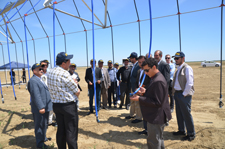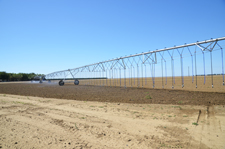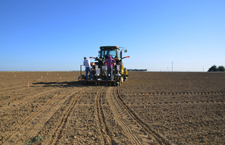Improving forage crop water productivity through innovative irrigation management
Summary:
Decreased and more variable water supplies are expected in California’s San Joaquin Valley in the future and are likely to hit the region’s forage production sector particularly hard. Improving crop water productivity through innovative irrigation management and drought-resilient tillage and residue management techniques will be increasingly imperative in this region. Recent technological advances in precision overhead irrigation systems that can be readily coupled with water-use-efficient tillage and residue management techniques and regulated deficit irrigation approaches may be a ‘cropping systems’ means for sustaining productivity and preserving the competitive agricultural capacity of the region. A team of research and extension, farmer, private sector, and federal government partners worked together to develop best irrigation and crop management practices by comparing full and regulated deficit irrigation strategies for apportioning limited water for production of sorghum and alfalfa to inform and improve future water management strategies.
Investigator:
Jeff Mitchell
Cropping Systems Specialist
Kearney Agricultural Research & Extension Center, UC Agriculture and Natural Resources
Collaborators:
- Dan Putnam, Department of Plant Sciences, UC Davis
- Jeffrey Dahlberg, Kearney Agricultural Research & Extension Center, UC Agriculture and Natural Resources
- Dan Munk, UC Agriculture and Natural Resources
Project description:
Decreased and more variable water supplies are expected in California’s San Joaquin Valley (SJV) in the future and are likely to hit the region’s forage production sector particularly hard. Improving crop water productivity through innovative irrigation management and drought-resilient tillage and residue management techniques will be increasingly imperative in this region if producers are to avoid repercussions due to shrinking water availability. Recent technological advances in precision overhead irrigation systems that can be readily coupled with water-use-efficient tillage and residue management techniques and regulated deficit irrigation approaches may be a ‘cropping systems’ means for sustaining productivity and preserving the competitive agricultural capacity of the region.
Two important SJV forage crops that lend themselves to these ‘drought-proofing’ strategies are sorghum and alfalfa. In this project, a team of UC and CSU Fresno research and extension, farmer, private sector, and NRCS partners worked together to develop best irrigation and crop management practices by comparing full and regulated deficit irrigation strategies for apportioning limited water for production of these forages. Our objectives were:
1. To determine the water use and economic efficiencies of forage alfalfa and sorghum under full evapotranspiration (ET), a moderate regulated deficit (75% ET), a severe deficit (50% ET), and a ‘seasonal drydown’ approach for restricting water applications during a ‘reduced risk’ period of vegetative growth for sorghum and late summer for alfalfa.
2. To measure crop responses and water productivity of these crops under limited water supplies.
3. To have these evaluations of overhead irrigation for these forages serve as the basis for intensive public extension education programs for precision crop management technologies through our Conservation Agriculture Systems Innovation (CASI) Center outreach networks.
We used a state-of-the-art center pivot system at the UC West Side Research and Extension Center in Five Points, CA that is equipped with drop hoses at 40” spacing, advance speed and water application control and in-line flow meters to impose these deficit irrigation regimes based on CIMIS and ETGage daily ET estimates. We generated soil water balance data based on profile water content sensing instrumentation. We provided three public extension education field days annually, real-time project data summaries at our CASI website, and both video and peer-reviewed article summaries of the project’s findings.
By using highly uniform center pivot irrigation technology to apply small, precise amounts of water particularly during the vegetative growth stage for sorghum and both immediately before and after monthly harvests and during the mid- to late-summer period for alfalfa when SJV productivity typically is reduced under flood irrigation, we expected to produce marketable and economic yields for sorghum using 25% less water as has been achieved under pivots in TX and similar increases in crop water productivity for alfalfa. This work will inform and improve future water management strategies in California.

UC Davis International Programs Office Afghanistan tour group visiting field site in Five Points, CA (Jeff Mitchell)

Three-span overhead pivot irrigation system, running to provide pre-irrigation water ahead of corn and sorghum planting (Jeff Mitchell)

Corn and sorghum planting in circular fashion using GPS (Jeff Mitchell)
